You may want to try genuine R plots, whose functions IMO might be less confusing and easier to learn, and which are definitely far better to customize.
There are two steps, defining labels and colors, then the plot with the legend.
# define labels and colors beforehand
mutants <- sort(unique(edtct3$Mutant)) # unique and alph. sorted mutants
clr <- hcl.colors(8, "Spectral")
op <- par(mar=c(5, 5, 4, 7.5)) # modify margins of plot region (B, L, T, R)
# plot
with(edtct3, plot(x=Time, y=Mean, type="n", ## empty plot: type="n"
main="Effective PSII Quantum Yield across SP1 Mutants",
ylab="Effective PSII Quantum Yield",
xlab="Actinic PPFD"))
# lines and points: loop over the mutants with an `sapply`
# the actual function is `lines()`
sapply(seq(mutants), function(x) ## `seq(mutants)` makes a loop sequence over the mutants
with(edtct3[edtct3$Mutant == mutants[x], ], ## subsetting
lines(x=Time, y=Mean, type="o", pch=16, col=clr[x]))) ## type="o" makes lines and points
# legend
legend(x=20.5, y=1.69, xpd=TRUE, legend=labs, pch=15, col=clr, cex=.9,
text.font=c(1, rep(3, 7))) ## recall the "face" vector from former question
par(op) # reset margins of plot region
Yields

Data:
edtc3 <- structure(list(Time = c(1, 1, 1, 1, 1, 1, 1, 1, 1, 1, 1, 1, 1,
1, 1, 1, 1, 1, 1, 1, 1, 1, 1, 1, 1, 1, 1, 1, 1, 1, 1, 1, 6, 6,
6, 6, 6, 6, 6, 6, 6, 6, 6, 6, 6, 6, 6, 6, 6, 6, 6, 6, 6, 6, 6,
6, 6, 6, 6, 6, 6, 6, 6, 6, 11, 11, 11, 11, 11, 11, 11, 11, 11,
11, 11, 11, 11, 11, 11, 11, 11, 11, 11, 11, 11, 11, 11, 11, 11,
11, 11, 11, 11, 11, 11, 11, 19, 19, 19, 19, 19, 19, 19, 19, 19,
19, 19, 19, 19, 19, 19, 19, 19, 19, 19, 19, 19, 19, 19, 19, 19,
19, 19, 19, 19, 19, 19, 19), Mutant = c("sp2-3 ppi1", "ppi1",
"WT", "sp2-6 ppi1", "sp2-4", "WT", "sp2-3 ppi1", "sp2-8 ppi1",
"sp2 ppi1", "ppi1", "sp2-6 ppi1", "sp2-8 ppi1", "sp2 ppi1", "sp2-6 ppi1",
"sp2-5 ppi1", "WT", "sp2-4", "sp2 ppi1", "sp2-4", "sp2-5 ppi1",
"sp2-5 ppi1", "sp2-4", "sp2 ppi1", "WT", "sp2-6 ppi1", "sp2-8 ppi1",
"sp2-3 ppi1", "sp2-8 ppi1", "ppi1", "ppi1", "sp2-3 ppi1", "sp2-5 ppi1",
"sp2-5 ppi1", "sp2-6 ppi1", "ppi1", "WT", "sp2-8 ppi1", "sp2-8 ppi1",
"sp2-3 ppi1", "sp2 ppi1", "ppi1", "sp2-6 ppi1", "WT", "sp2-8 ppi1",
"WT", "sp2-3 ppi1", "sp2-5 ppi1", "ppi1", "sp2-3 ppi1", "sp2-6 ppi1",
"sp2-5 ppi1", "sp2-3 ppi1", "sp2 ppi1", "sp2-5 ppi1", "sp2 ppi1",
"ppi1", "sp2-4", "sp2-4", "sp2-4", "sp2-4", "WT", "sp2 ppi1",
"sp2-6 ppi1", "sp2-8 ppi1", "sp2 ppi1", "sp2-4", "sp2-4", "sp2-8 ppi1",
"sp2-4", "sp2-3 ppi1", "sp2-8 ppi1", "sp2-4", "WT", "sp2 ppi1",
"ppi1", "sp2 ppi1", "sp2-5 ppi1", "WT", "sp2-3 ppi1", "sp2-3 ppi1",
"sp2-3 ppi1", "sp2-6 ppi1", "sp2-5 ppi1", "ppi1", "ppi1", "sp2-8 ppi1",
"sp2 ppi1", "WT", "WT", "sp2-6 ppi1", "sp2-5 ppi1", "ppi1", "sp2-5 ppi1",
"sp2-6 ppi1", "sp2-6 ppi1", "sp2-8 ppi1", "sp2-3 ppi1", "sp2 ppi1",
"sp2-5 ppi1", "sp2-6 ppi1", "sp2-3 ppi1", "sp2-4", "sp2-4", "sp2-6 ppi1",
"sp2-5 ppi1", "sp2-4", "sp2-8 ppi1", "ppi1", "ppi1", "WT", "sp2 ppi1",
"sp2 ppi1", "ppi1", "sp2-6 ppi1", "ppi1", "sp2-4", "sp2-5 ppi1",
"sp2-3 ppi1", "sp2-6 ppi1", "sp2-5 ppi1", "sp2-8 ppi1", "WT",
"sp2 ppi1", "sp2-8 ppi1", "sp2-3 ppi1", "sp2-8 ppi1", "WT", "WT"
), Mean = c(0.91, 0.59, 1.14, 0.74, 1.08, 1.65, 0.77, 1.34, 0.65,
0.61, 0.86, 1.3, 0.82, 0.84, 0.97, 1.29, 1.15, 0.84, 1, 1.04,
0.78, 1.01, 1.02, 1.33, 0.88, 1.25, 0.78, 1.25, 0.8, 0.67, 0.85,
0.9, 1.04, 0.84, 0.67, 1.65, 1.25, 1.34, 0.77, 1.02, 0.59, 0.88,
1.33, 1.3, 1.29, 0.91, 0.78, 0.8, 0.78, 0.86, 0.9, 0.85, 0.84,
0.97, 0.65, 0.61, 1.01, 1.08, 1.15, 1, 1.14, 0.82, 0.74, 1.25,
1.02, 1.08, 1.15, 1.25, 1.01, 0.85, 1.25, 1, 1.29, 0.84, 0.59,
0.82, 1.04, 1.33, 0.77, 0.91, 0.78, 0.86, 0.78, 0.67, 0.61, 1.34,
0.65, 1.65, 1.14, 0.84, 0.9, 0.8, 0.97, 0.74, 0.88, 1.3, 0.78,
0.84, 1.04, 0.88, 0.91, 1.01, 1.15, 0.74, 0.78, 1, 1.3, 0.67,
0.8, 1.14, 1.02, 0.82, 0.59, 0.84, 0.61, 1.08, 0.9, 0.77, 0.86,
0.97, 1.34, 1.29, 0.65, 1.25, 0.85, 1.25, 1.65, 1.33)), row.names = c("17",
"5", "1", "25", "10", "4", "18", "32", "15", "7", "27", "31",
"14", "26", "24", "3", "9", "16", "11", "22", "21", "12", "13",
"2", "28", "29", "19", "30", "6", "8", "20", "23", "221", "261",
"81", "41", "291", "321", "181", "131", "51", "281", "210", "311",
"33", "171", "211", "61", "191", "271", "231", "201", "161",
"241", "151", "71", "121", "101", "91", "111", "110", "141",
"251", "301", "132", "102", "92", "292", "122", "202", "302",
"112", "34", "162", "52", "142", "222", "212", "182", "172",
"192", "272", "213", "82", "72", "322", "152", "42", "113", "262",
"232", "62", "242", "252", "282", "312", "193", "163", "223",
"283", "173", "123", "93", "253", "214", "114", "313", "83",
"63", "115", "133", "143", "53", "263", "73", "103", "233", "183",
"273", "243", "323", "35", "153", "303", "203", "293", "43",
"215"), class = "data.frame")




